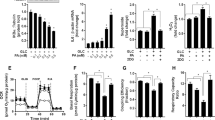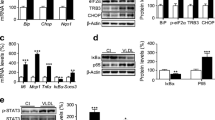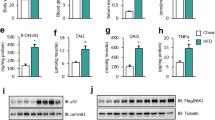Abstract
Adipose tissue is an important endocrine and metabolic tissue that is actively involved in cross-talk with peripheral organs such as skeletal muscle. It is likely that adipose-derived factors may underlie the development of insulin resistance in muscle. Thus, the cross-talk between adipose and muscle may be important for the propagation of obesity-related diseases. Visfatin (Pre-B-cell colony-enhancing factor 1 homolog/Nampt) is a recently discovered adipokine with pleiotropic functions. The aim of this study was to examine the effect of visfatin on cellular stress responses and signalling pathways in skeletal muscle. Visfatin treatment of differentiated C2C12 myotubes generated reactive oxygen species (ROS) comprising both superoxide and hydrogen peroxide that was dependent on de novo transcription and translation. In differentiated C2C12 myoblasts, visfatin had no effects on insulin-stimulated Akt phosphorylation nor on activation of the Akt signalling pathway. Additionally, visfatin-induced oxidative stress occurred independent of activation of the stress-activated protein kinases (MAPKs) ERK and p38. In contrast, phosphorylation of NFĸB was associated with visfatin-mediated generation of ROS and blockade of this pathway via selective IKK inhibition led to a partial reduction in oxidative stress. Furthermore, the generation of ROS following visfatin treatment was highly dependent on both de novo transcription and translation. Taken together, these findings provide novel insights for the unique pathophysiological role of visfatin in skeletal muscle.






Similar content being viewed by others
References
Aam BB, Myhre O, Fonnum F (2003) Transcellular signalling pathways and TNF-alpha release involved in formation of reactive oxygen species in rat alveolar macrophages exposed to tert-butylcyclohexane. Arch Toxicol 77(12):678–684
Adams JD Jr (2008) Alzheimer's disease, ceramide, visfatin and NAD. CNS Neurol Disord Drug Targets 7(6):492–498
Adya R, Tan BK, Punn A et al (2008) Visfatin induces human endothelial VEGF and MMP-2/9 production via MAPK and PI3K/Akt signalling pathways: novel insights into visfatin-induced angiogenesis. Cardiovasc Res 78(2):356–365
Aldhahi W, Hamdy O (2003) Adipokines, inflammation, and the endothelium in diabetes. Curr Diab Rep 3(4):293–298
Anrather J, Racchumi G, Iadecola C (2006) NF-kappaB regulates phagocytic NADPH oxidase by inducing the expression of gp91phox. J Biol Chem 281(9):5657–5667
Bajwa EK, Yu CL, Gong MN et al (2007) Pre-B-cell colony-enhancing factor gene polymorphisms and risk of acute respiratory distress syndrome. Crit Care Med 35(5):1290–1295
Bo S, Ciccone G, Baldi I et al (2009) Plasma visfatin concentrations after a lifestyle intervention were directly associated with inflammatory markers. Nutr Metab Cardiovasc Dis 19(6):423–430
Busso N, Karababa M, Nobile M et al (2008) Pharmacological inhibition of nicotinamide phosphoribosyltransferase/visfatin enzymatic activity identifies a new inflammatory pathway linked to NAD. PLoS ONE 3(5):e2267
Chaldakov GN, Stankulov IS, Hristova M et al (2003) Adipobiology of disease: adipokines and adipokine-targeted pharmacology. Curr Pharm Des 9(12):1023–1031
Dietze D, Koenen M, Röhrig K et al (2002) Impairment of insulin signaling in human skeletal muscle cells by co-culture with human adipocytes. Diabetes 51(8):2369–2376
Dietze D, Ramrath S, Ritzeler O et al (2004) Inhibitor kappaB kinase is involved in the paracrine crosstalk between human fat and muscle cells. Int J Obes Relat Metab Disord 28(8):985–992
Dietze-Schroeder D, Sell H, Uhlig M et al (2005) Autocrine action of adiponectin on human fat cells prevents the release of insulin resistance-inducing factors. Diabetes 54(7):2003–2011
Frydelund-Larsen L, Akerstrom T, Nielsen S et al (2007) Visfatin mRNA expression in human subcutaneous adipose tissue is regulated by exercise. Am J Physiol Endocrinol Metab 292(1):E24–E31
Garten A, Petzold S, Körner A et al (2009) Nampt: linking NAD biology, metabolism and cancer. Trends Endocrinol Metab 20(3):130–138
Hong SB, Huang Y, Moreno-Vinasco L et al (2008) Essential role of pre-B-cell colony enhancing factor in ventilator-induced lung injury. Am J Respir Crit Care Med 178(6):605–617
Hug C, Lodish HF (2005) Medicine. Visfatin: a new adipokine. Science 307(5708):366–367
Jensen MD (2008) Role of body fat distribution and the metabolic complications of obesity. J Clin Endocrinol Metab 93(11 Suppl 1):S57–S63
Kamiya T, Hara H, Yamada H et al (2008) Cobalt chloride decreases EC-SOD expression through intracellular ROS generation and p38-MAPK pathways in COS7 cells. Free Radic Res 42(11–12):949–956
Kim JH, Bachmann RA, Chen J (2009) Interleukin-6 and insulin resistance. Vitam Horm 80:613–633
Kim SR, Bae SK, Choi KS et al (2007) Visfatin promotes angiogenesis by activation of extracellular signal-regulated kinase ½. Biochem Biophys Res Commun 357(1):150–156
Kim SR, Bae YH, Bae SK et al (2008) Visfatin enhances ICAM-1 and VCAM-1 expression through ROS-dependent NF-kappaB activation in endothelial cells. Biochim Biophys Acta 1783(5):886–895
Krzysik-Walker SM, Ocón-Grove OM, Maddineni SR et al (2008) Is visfatin an adipokine or myokine? Evidence for greater visfatin expression in skeletal muscle than visceral fat in chickens. Endocrinology 149(4):1543–1550
Ku BM, Lee YK, Jeong JY et al (2007) Ethanol-induced oxidative stress is mediated by p38 MAPK pathway in mouse hippocampal cells. Neurosci Lett 419(1):64–67
Lee WJ, Wu CS, Lin H et al (2009) Visfatin-induced expression of inflammatory mediators in human endothelial cells through the NF-kappaB pathway. Int J Obes (Lond) 33(4):465–472
Li X, Rong Y, Zhang M et al (2009) Up-regulation of thioredoxin interacting protein (Txnip) by p38 MAPK and FOXO1 contributes to the impaired thioredoxin activity and increased ROS in glucose-treated endothelial cells. Biochem Biophys Res Commun 381(4):660–665
Lim SY, Davidson SM, Paramanathan AJ et al (2008) The novel adipocytokine visfatin exerts direct cardioprotective effects. J Cell Mol Med 12(4):1395–1403
Lin BR, Yu CJ, Chen WC et al (2009) Green tea extract supplement reduces D-galactosamine-induced acute liver injury by inhibition of apoptotic and proinflammatory signalling. J Biomed Sci 16(1):35
Liu SW, Qiao SB, Yuan JS et al (2009) Visfatin stimulates production of monocyte chemotactic protein-1 and interleukin-6 in human vein umbilical endothelial cells. Horm Metab Res 41(4):281–286
Lorenzo M, Fernández-Veledo S, Vila-Bedmar R et al (2008) Insulin resistance induced by tumor necrosis factor-alpha in myocytes and brown adipocytes. J Anim Sci 86(14 Suppl):E94–E104
Lovren F, Pan Y, Shukla PC et al (2009) Visfatin activates eNOS via Akt and MAP kinases and improves endothelial function. Am J Physiol Endocrinol Metab 296(6):E1440–E1449
Martin PR, Shea RJ, Mulks MH (2001) Identification of a plasmid-encoded gene from Haemophilus ducreyi which confers NAD independence. J Bacteriol 183(4):1168–1174
Moschen AR, Kaser A, Enrich B et al (2007) Visfatin, an adipocytokine with proinflammatory and immunomodulating properties. J Immunol 178(3):1748–1758
Munhoz CD, García-Bueno B, Madrigal JL et al (2008) Stress-induced neuroinflammation: mechanisms and new pharmacological targets. Braz J Med Biol Res 41(12):1037–1046
Myhre O, Sterri SH, Bogen IL et al (2004) Erk1/2 phosphorylation and reactive oxygen species formation via nitric oxide and Akt-1/Raf-1 crosstalk in cultured rat cerebellar granule cells exposed to the organic solvent 1, 2, 4-trimethylcyclohexane. Toxicol Sci 80(2):296–303
Nieto-Vazquez I, Fernández-Veledo S, Krämer DK (2008) Insulin resistance associated to obesity: the link TNF-alpha. Arch Physiol Biochem 114(3):183–194 Review
Ognjanovic S, Bao S, Yamamoto SY (2001) Genomic organization of the gene coding for human pre-B-cell colony enhancing factor and expression in human fetal membranes. J Mol Endocrinol 26(2):107–117
Pajvani UB, Scherer PE (2003) Adiponectin: systemic contributor to insulin sensitivity. Curr Diab Rep 3(3):207–213
Rabe K, Lehrke M, Parhofer KG et al (2008) Adipokines and insulin resistance. Mol Med 14(11–12):741–751
Revollo JR, Körner A, Mills KF et al (2007) Nampt/PBEF/Visfatin regulates insulin secretion in beta cells as a systemic NAD biosynthetic enzyme. Cell Metab 6(5):363–375
Roncari DA, Hamilton BS (1993) Cellular and molecular factors in adipose tissue growth and obesity. Adv Exp Med Biol 334:269–277
Rongvaux A, Andris F, Van Gool F et al (2003) Reconstructing eukaryotic NAD metabolism. Bioessays 25(7):683–690 Review
Ronti T, Lupattelli G, Mannarino E (2006) The endocrine function of adipose tissue: an update. Clin Endocrinol (Oxf) 64(4):355–365
Samal B, Sun Y, Stearns G et al (1994) Cloning and characterization of the cDNA encoding a novel human pre-B-cell colony-enhancing factor. Mol Cell Biol 14(2):1431–1437
Seip M, Trygstad O (1996) Generalized lipodystrophy, congenital and acquired (lipoatrophy). Acta Paediatr Suppl 413:2–28
Sell H, Eckardt K, Taube A (2008) Skeletal muscle insulin resistance induced by adipocyte-conditioned medium: underlying mechanisms and reversibility. Am J Physiol Endocrinol Metab 294(6):E1070–E1077
Sell H, Eckel J, Dietze-Schroeder D, 2 (2006) Pathways leading to muscle insulin resistance—the muscle—fat connection. Arch Physiol Biochem 112(2):105–113 Review
Sharma AM (2006) The obese patient with diabetes mellitus: from research targets to treatment options. Am J Med 119(5 Suppl 1):S17–S23
Skurk T, Alberti-Huber C, Herder C et al (2007) Relationship between adipocyte size and adipokine expression and secretion. J Clin Endocrinol Metab 92(3):1023–1033
Song HK, Lee MH, Kim BK et al (2008) Visfatin: a new player in mesangial cell physiology and diabetic nephropathy. Am J Physiol Renal Physiol 295(5):F1485–F1494
Sonnenberg GE, Krakower GR, Kissebah AH (2004) A novel pathway to the manifestations of metabolic syndrome. Obes Res 12(2):180–186
Takebayashi K, Suetsugu M, Wakabayashi S et al (2007) Association between plasma visfatin and vascular endothelial function in patients with type 2 diabetes mellitus. Metabolism 56(4):451–458
Taki K, Shimozono R, Kusano H et al (2008) Apoptosis signal-regulating kinase 1 is crucial for oxidative stress-induced but not for osmotic stress-induced hepatocyte cell death. Life Sci 83(25–26):859–864
Viollet B, Mounier R, Leclerc J et al (2007) Targeting AMP-activated protein kinase as a novel therapeutic approach for the treatment of metabolic disorders. Diabetes Metab 33(6):395–402
Windelborn JA, Lipton P (2008) Lysosomal release of cathepsins causes ischemic damage in the rat hippocampal slice and depends on NMDA-mediated calcium influx, arachidonic acid metabolism, and free radical production. J Neurochem 106(1):56–69
Xiao J, Xiao ZJ, Liu ZG et al (2009) Involvement of dimethylarginine dimethylaminohydrolase-2 in visfatin-enhanced angiogenic function of endothelial cells. Diabetes Metab Res Rev 25(3):242–249
Xie H, Tang SY, Luo XH et al (2007) Insulin-like effects of visfatin on human osteoblasts. Calcif Tissue Int 80(3):201–210
Yamawaki H, Hara N, Okada M et al (2009) Visfatin causes endothelium-dependent relaxation in isolated blood vessels. Biochem Biophys Res Commun 383(4):503–508
Yu YH, Ginsberg HN (2005) Adipocyte signaling and lipid homeostasis: sequelae of insulin-resistant adipose tissue. Circ Res 96(10):1042–1052
Zhang LQ, Adyshev DM, Singleton P et al (2008) Interactions between PBEF and oxidative stress proteins—a potential new mechanism underlying PBEF in the pathogenesis of acute lung injury. FEBS Lett 582(13):1802–1808
Acknowledgements
RCO is supported by the NUCSYS Marie Curie Research Training Network funded by the European Union (contract number: MRTN-CT-019496).
Author information
Authors and Affiliations
Corresponding author
Rights and permissions
About this article
Cite this article
Oita, R.C., Ferdinando, D., Wilson, S. et al. Visfatin induces oxidative stress in differentiated C2C12 myotubes in an Akt- and MAPK-independent, NFĸB-dependent manner. Pflugers Arch - Eur J Physiol 459, 619–630 (2010). https://doi.org/10.1007/s00424-009-0752-1
Received:
Revised:
Accepted:
Published:
Issue Date:
DOI: https://doi.org/10.1007/s00424-009-0752-1




